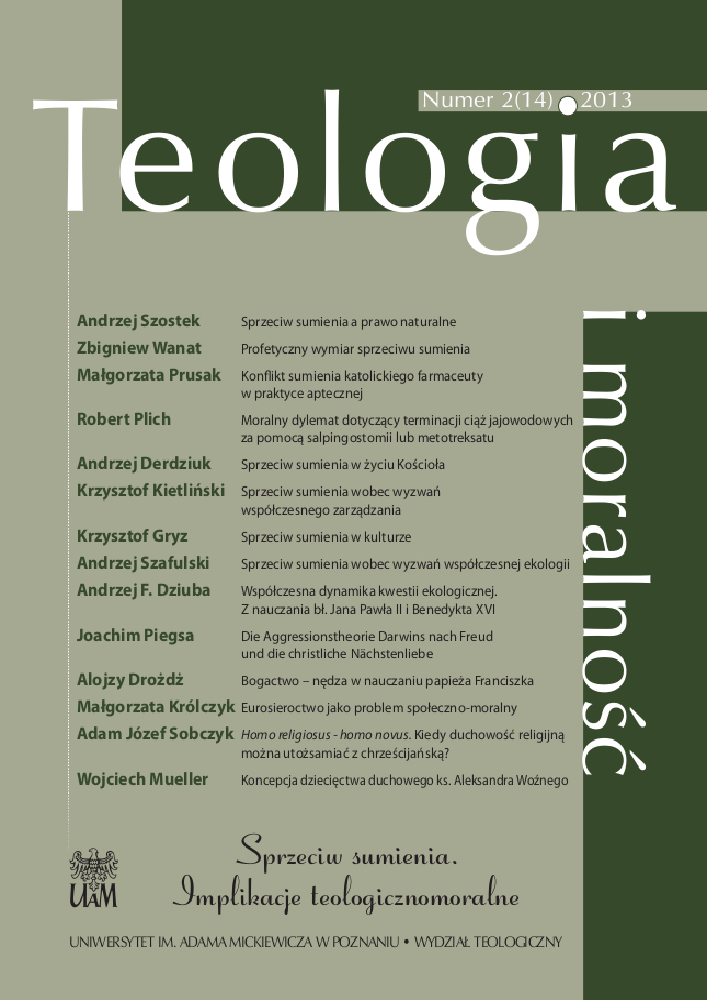Abstrakt
Wśród uznanych katolickich teoretyków moralności trwa debata na temat dwóch metod roz-wiązywania ciąży pozamacicznych: jedną z nich jest operacja zwana “salpingostomią” a drugą zastosowanie środka farmaceutycznego o nazwie “metotreksat”. Debata ta została podjęta z dwóch powodów: po pierwsze, wynalezienie i popularyzacja tych metod wymaga ich moralnej oceny, i po drugie, na razie nie istnieje specyficzne nauczanie moralne Magisterium dotyczące explicite każdej z tych metod. Wielu katolickich teologów moralnych i etyków ocenia te dwie metody, zgodnie z tradycyjnymi pryncypiami moralnymi, jako bezpośrednie zabicie embrionu (niewinnej osoby ludzkiej) i dlatego postrzega je jako akty moralnie niedopuszczalne. Jednak istnieją inni, którzy także chcą pozostać wierni nauczaniu Magisterium, ale stosują inną interpretację i zastosowanie tych samych tradycyjnych pryncypiów i dlatego uważają te dwie metody za pośrednie zabicie embrionu, czyli akty moralnie dopuszczalne. Niniejszy artykuł stanowi pierwszą część prezentacji argumentów wysuniętych prze obydwie strony tej moralnej debaty. w jest wyrazem poszanowania godności każdego człowieka; jak też przeciwstawienia się łamaniu podstawowych praw; jakimi są: prawo do życia oraz prawo do działania zgodnie z wewnętrznym przekonaniem. Na koniec zwrócono uwagę na obowiązujący także farmaceutę wymóg dawania świadectwa o prawdzie moralnej w odniesieniu do ostatecznego celu życia człowieka; jakim jest zjednoczenie z Bogiem.; Dopiero takie kompleksowe spojrzenie daje rzeczywisty obraz konfliktu moralnego farmaceuty wynikającego z; zobowiązywania go do sprzedaży środków; których stosowanie jest sprzeczne z jego sumieniem.Bibliografia
ANDERSON, Marie A., FASTIGGI Robert L., HARGRODER David E., HOWARD JR. Joseph C., Ward KISCHER C., „Ectopic Pregnancy and Catholic Morality. A Response to Recent Arguments in Favor of Salpingostomy and Methotrexate”, w: National Catholic Bioethics Quarterly 11(1) 2011, s. 667-684.
ASHLEY Benedict M. OP, O’ROURKE Kevin D., OP, Health Care Ethics. A Theological Analysis, Georgetown University Press, Washington, D.C., 1997.
ASHLEY Benedict M. OP, O’ROURKE Kevin D., OP,, Ethics of Health Care. An Introductory Textbook, Georgetown University Press, Washington, D.C., 2002.
BOUSCAREN Lincoln T. SJ, Ethics of Ectopic Operations, The Bruce Publishing Company, Milwaukee Wisconsin 1944.
BOWRING Kelly, “The Moral Dilemma of Management Procedures for Ectopic Pregnancy,” w: Life and Learning, t. XII, Proceedings of the Twelfth University Faculty for Life Conference at Ave Maria Law School 2002, red. Joseph W. Koterski, S.J., University Faculty for Life, Washington, D.C., 2003, s. 97-126.
CANNON, L., JESIONOWSKA H., „Methotrexate Treatment of Tubal Pregnancy”, w: Fertility and Sterility 55 (6) 1991, s. 1033-1038.
CLARK Peter A., “Methotrexate and Tubal Pregnancies: Direct or Indirect Abortion?”, w: Linacre Quartery67 (1) 2000, s. 7–24.
DIAMOND Eugene F., „Moral and Medical Considerations in the Management of Extrauterine Pregnancy”, w: Linacre Quarterly 66 (3) 1999, s. 5-15.
FLANNERY Kevin SJ, “What Is Included in a Means to an End?”, w: Gregorianum 74 (3) 1993, s. 499-513.
FURTON Edward, “The Direct Killing of the Innocent”, w: Ethics and Medics 35 (10) 2010, s. 1-2.
GRISEZ Germain, Abortion: The Myths, the Realities, and the Arguments, Corpus Books, Cleveland/New York 1970.
GRISEZ Germain, The Way of the Lord Jesus, t. I: Christian Moral Principles, Quincy Illinois 1997.
GRISEZ Germain, FINNIS John, BOYLE Joseph, “‘Direct’ and ‘Indirect’: a Reply to Critics of Our Action Theory”, w: The Thomist, 65, 2001, s. 1-44.
GUEVIN Benedict M. OSB, „Vital Conflicts and Virtue Ethics”, w: National Catholic Bioethics Quarterly 10 (3) 2010, s. 471-480.
KACZOR Christopher, „The Ethics of Ectopic Pregnancy. A Critical Reconsideration of Salpingostomy and Methotrexate”, w: The Linacre Quarterly 76 (3) 2009, s. 265-282.
MAY William E.,„The Management of Ectopic Pregnancies: A Moral Analysis”, w: The Fetal Tissue Issue. Medical and Ethical Aspects, red. Peter J. Cataldo, Albert S. Moraczewski OP, The Pope John XXIII Center, Braintree, MA 1994, s. 121-147.
MAY William E., „Methotrexate and Ectopic Pregnancy”, w: Ethics and Medics 23 (3) 1998, s. 1-3.
MAY William E., Catholic Bioethics and The Gift of Human Life, Our Sunday Visitor Publishing Division, Huntington IN 2000, 2008.
MAY William E., „Ethical Arguments Against Salpingostomy and Methotrexate”, w: Catholic Health Care Ethics. A Manual for Ethics Committees, red. Peter J. Cataldo i Albert S. Moraczewski OP, The National Catholic Bioethics Center, Boston MA 2001, s. 10B/1-3.
MORACZEWSKI Albert OP, „Managing Tubal Pregnancies”, cz. I, w: Ethics and Medics 21 (6) 1996, s. 3-4.
MORACZEWSKI Albert OP, “Managing Tubal Pregnancies”, cz. II, w: Ethics and Medics 21 (8) 1996, s. 3-4.
MORACZEWSKI Albert OP, „Ectopic Pregnancy Revisited”, w: Ethics and Medics 23 (3) 1998, s. 3-4.
MORACZEWSKI Albert OP, „Ethical Arguments in Favor of Salpingostomy and Methotrexate”, w: Catholic Health Care Ethics. A Manual for Ethics Committees, red. Peter J. Cataldo i Albert S. Moraczewski OP, The National Catholic Bioethics Center, Boston MA 2001, s. 10B/3-4.
PLICH Robert OP, „Położnicza operacja kraniotomii w orzeczeniach Magisterium Kościoła” w: Studia Bobolanum 2, 2010, s. 123-137.
RHONHEIMER Martin,Vital Conflicts in Medical Ethics. A Virtue Approach to Craniotomy and Tubal Pregnancies, The Catholic University of America Press, Washington D.C. 2009.
DENZINGER Henricus, SCHÖNMETZER Adolfus SJ, Enchiridion Symbolorum, definitionum et declarationum de rebus fidei et morum,ed. XXXIII, Herder, Barcinone – FriburgiBrisgoviae – Romae – Neo-Eboraci, MCMLXV.
SHETTLES, L., „Tubal Embryo Successfully Transplanted in Utero”, w: American Journal of Obstetrics and Gynecology 163, 1990, s. 2026-2027.
THOMPSON,John D., ROCK John A., TeLinde’s Operative Gynecology, J.B. Lippincott Co., Philadelphia 1992.
UNITED STATES CONFERENCE OF CATHOLIC BISHOPS, Ethical and Religious Directives for Catholic Health Care Services, wydanie V, Washington, D.C.,: USCCB, 2009.
WALLACE, C. J., „Transplantation of Ectopic Pregnancy from Fallopian Tube to Cavity of Uterus”, w: Surgery Gynecology, and Obstetrics 24, 1917, s. 578-579, reprint w: Linacre Quarterly, 62 (1) 1995, s. 67-69.
WILCOX, A. J. D., BAIRD D., WEINBERG C. R., "Time of implantation of the Conceptus and loss of pregnancy", w: New England Journal of Medicine 340 (23) 1999, s. 1796–1799.
Licencja
Prawa autorskie są zastrzeżone
